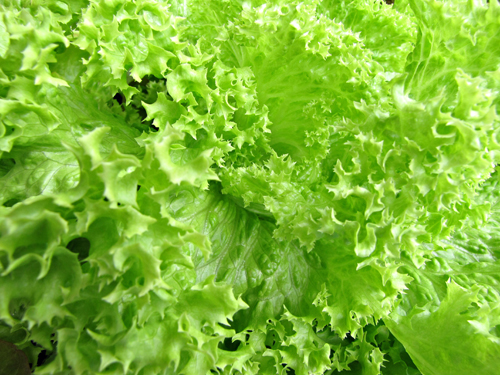Lettuce deficiency and toxicity symptoms of macro and micro elements
It is often quite difficult to identify a deficiency or toxicity symptom in the field because they never really occur as a single element deficiency or toxicity. Each of the elements are inter dependent and they influence each other within certain ratio’s. One would find for instance that phosphorus toxicity, is expressed as either a zinc or copper deficiency because of the suppressing effect phosphorus has on the uptake of these two elements.
The tables below provide a basic summary of the effects of deficiencies or toxicities on most vegetable crops with the emphasis on lettuce. The table should be used as a basic reference point from where one would develop further theories of what is wrong with the plant.
Some of the deficiency and toxicity symptoms of micro elements found in lettuce are provided in the second table.
A summary of the effects of toxicities and deficiencies of five macro elements.| Element | Toxicity | Deficiency |
|---|---|---|
| Nitrogen | Light green leaves Lower leaves yellow Stalks short & slender Older leaves affected first Younger leaves remain green No head forms with severe deficiency Has very dens root system | Leaves very dark green Restricted root system Ammonia: necrotic leaves leaving only the veins green Leaves are small and resemble spinach in form |
| Phosphorus | Stunted abnormal dark green No specific symptoms to identify Purple pigmentation under leaves No necrosis tissue | Yellowing of older leaves Older leaf tips become yellow Leaf abscission develops Copper & zinc deficiency are more likely to appear Iron precipitates in water especially at low pH |
| Potassium | Weak plant No resistance to water stress Sodium replaces K on short term Older leaves first Chlorosis at leaf tips and between veins Growth is stunted Small leaves Leaves are less crinkled Purple leaf margins | Induces a deficiency symptom of other elements. |
| Calcium | Growth severely stunted Leaf have open rosette growth Interveinal white spots near margins of mature leaves Leaves more crinkled than normal Plant growth is also flat Older leaves curl downwards Leaves are brittle Chlorosis and later necrosis in leaf margins Could be induced by high potassium | Hardly ever shown as Ca toxicity Rather expresses in terms of Fe, K or Mg effects |
| Magnesium | Very mobile element Symptoms first in younger leaves Symptoms fist as interveinal chlorosis Moderate deficiency – overall plant colour is light green Leaves have mottled appearance Plants are smaller Margins curl upwards Yellow spots in interveinal areas Green margin even in severe cases Induced by high potassium, calcium, ammonium or low pH | Marginal scorching Dark green leaves Very rare |
| Sulphur | S and N are closely related in metabolism Symptoms are closely related to N Deficiencies are rare Plants stunted and woody Heart of plant light green Leaves are thicker Anthocyanin discolouration on leaf edges | Plants are tolerant of high sulphur Symptoms do not show up to 600ppm in solution Plants feel hard Leaves bluish green Extreme cases leaf margins brown High S content limits Ca uptake Induces Mo deficiency |
| Element | Deficiency | Toxicity |
|---|---|---|
| Iron | Influences new growth Interveinal chlorosis of young leaves Whole plant is light green Growth is stunted and stops Check excessive manganese Veins remain green initially Fe deficiency is usually induced Low oxygen content can induce Fe deficiency Leaves are less crinkled Check for anthocyanin discolouration in young leaves | Very rare phenomenon Spotting of leaves initially Total browning of leaf later |
| Boron | Immobile in plant Restricted root growth Plant darker than normal Young leaves hard and rounded Brown spots at growth points Growth point dies with severe deficiency Poor root development Plants have dwarf appearance Can be confused with tip burn | Leaves appear scorched at margins Necrotic spots feels papery Symptoms in older leaves first Toxicity in older leaves first Leaf margins turn yellow, cup downward |
| Manganese | Relative immobile in plant Entire plant light green to yellow Young leaves are smoother Overall pale appearance Older leaves may become chlorotic Veins always remain green vs. Fe where the become pale to white | Leaves show marginal chlorosis Spots on older leaf margins Spots coalesce from margin inwards Older leaves may die Young leaves are stunted Heads are loose |
| Zinc | Careful with P fertilizer Induced by P fertilization Upper internodes remain short Rosette appearance (like a Rose) Growth stunted Leaf margins show necrotic spots Can be mistaken for chemical scorch Older leaves first | Plant has brown-green colour Growth stunted Middle leaves red-brown spots No head forms with acute toxicity Leaves are long and narrow Older leaves yellow and die |
| Copper | Leaves become elongated and cupped Interveinal chlorotic blotches Plant remains small Leaf margins turn up Chlorosis along edges Leaves wilt at a later stage No heads form | Expresses as Fe chlorosis |
| Molybdenum | Pale distorted very narrow leaves Interveinal yellowing Plants are stunted Leaf wither from margins and tip Necrotic spots appear and coalesce Symptoms progress from old to young leaves Root growth stunted Plants can collapse entirely |



